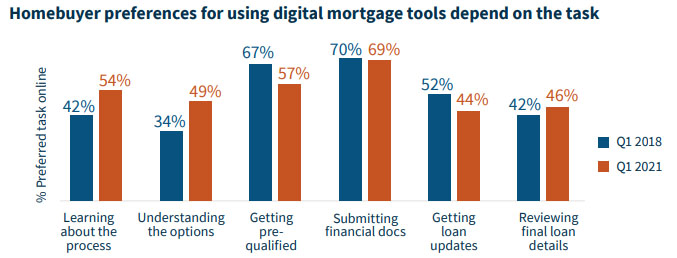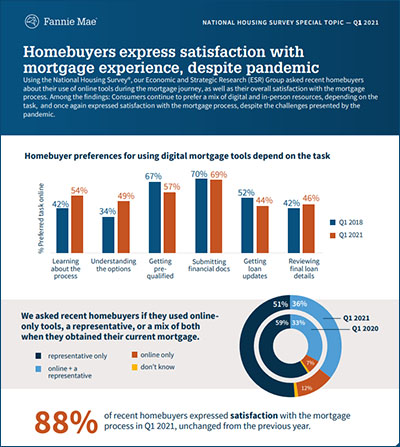The Pandemic's Impact on Mortgage Digitization and Homebuyer Satisfaction
As part of Fannie Mae’s Q1 2021 National Housing Survey, we asked recent homebuyers – those who purchased a home in 2020 with mortgage origination dates between May 1, 2020 and December 1, 2020 – about their mortgage experience during the COVID-19 pandemic. Specifically, we asked about their mortgage satisfaction, and if the challenges presented during the pandemic encouraged them to use more digital processes throughout their mortgage journey. We wanted to better understand how the pandemic may have changed the digital behavior of consumers seeking a mortgage, as it did in many other industries.1
We learned that, overall, consumers felt satisfied with their mortgage experience, despite lenders moving to remote working conditions and handling record-high origination volume. Credit unions and traditional banks received slightly higher satisfaction rates than mortgage banks. Interestingly, and contrary to our expectations, consumers did not report a sizable increase in their use of online channels for their mortgage tasks, although there was a slight increase from previous years. Among consumer segments, there were differences in online preferences, indicating that a “one size fits all” digital process may not be the right approach to best meet the needs of all consumer groups.
Mortgage Digitization
Our hypothesis was that conducting mortgage tasks exclusively online would become more prevalent during the pandemic period. However, while there was a small but significant increase in consumers using online-only channels compared to the previous year (12% vs. 7%, respectively), most recent homebuyers still wanted the ability to speak with a representative throughout the mortgage process. Considering that a mortgage is often a consumer’s largest expense – and that it tends to be more complicated than other purchases – it makes sense that people may not be willing to give up in-person discussions and advice regarding such a large, complex, and infrequent purchase.
Additionally, we learned that first-time homebuyers were more willing to authorize electronic access to their records compared to repeat homebuyers (41% vs. 33%, respectively). This could be an early indication of a demographic shift: As millennials start to buy more homes, they may be more willing to allow lenders to access their records electronically, since many younger consumers grew up allowing digital apps and online companies access to their financial information.
Of those who used digital channels, a majority of recent borrowers (57%) said the pandemic had no impact on their decision to use digital channels, but a reasonable proportion (38%) did indicate that the pandemic had some influence on their decision to use digital channels.
Compared to 2018, there was an increase in recent homebuyers preferring to do early mortgage tasks online, such as learning about the mortgage process or better understanding different terms and options, but later tasks, including pre-qualification or getting updates about their loan, showed a decrease in preference for online tools. In 2020, online preference continued to hover around 50% or lower for most tasks, except submitting financial documents, which was nearly 70%, further confirming borrowers’ desire for continued in-person help and support as they navigate the mortgage process.
Additional differences were illuminated after looking at online mortgage task preferences by race and income levels. Of the recent homebuyers surveyed in 2020, higher-income, Asian, and Black respondents showed a stronger preference for conducting mortgage tasks online, while lower-income and Hispanic consumers demonstrated a stronger preference for conducting tasks with an in-person representative or by phone. Again, this data demonstrates there is not a single, best approach to helping consumers through the mortgage process, and businesses and lenders should be sensitive to the diverse needs of individuals and groups.
Mortgage Satisfaction During the Pandemic
Consumer mortgage satisfaction remained high during the pandemic year, despite most lenders facing the challenges of remote working and increased volume. In Q1 2021, 88% of recent homebuyers expressed satisfaction with their mortgage process, a level unchanged from Q1 2020.
These consumer satisfaction ratings are unlikely to come as a surprise to most lenders, as the results align with other findings from the Fannie Mae Economic and Strategic Research Group. As part of our Q1 2021 Mortgage Lender Sentiment Survey, 78% of lenders told us that the consumer mortgage experience had improved or remained the same during the pandemic.
We also dug deeper to better understand consumer satisfaction across the different types of mortgage lending institutions. Recent homebuyers were slightly more satisfied with traditional banks (90%) and credit unions (93%) compared to mortgage banks (85%). Additionally, when segmented by size, small and mid-sized lenders had significantly more “very satisfied” consumers compared to larger lending institutions.
In conclusion, consumer satisfaction in the mortgage experience remained high during the pandemic, but the change in consumers using online processes was not as large as we expected. The shift to digital continues to be a gradual process, with certain segments showing different online servicing/in-person needs. Since buying a home is an infrequent and complicated expense, shifting to online-only channels appears to be an imperfect solution for many borrowers who have questions and want to make the right choices.
Additionally, with such a large expense item, some consumers may expect a higher level of service than they might for their everyday online purchases. We will continue to monitor consumer preferences as demographics shift and younger generations engage further in the homebuying journey, to see if online preferences for mortgage tasks increase or plateau. To create more significant consumer interest and usage in a fully digital mortgage process, the industry may need to think about ways to further streamline and uncomplicate the process for consumers, as well as make costs, rates, and information more transparent, so that consumers feel comfortable with a fully online mortgage experience.
To learn more, read the research deck or access our infographic.
Tim McCallum, Vice President, Single-Family Customer Management Solutions
Jenney Shen, Vice President, Single-Family Customer Management Solutions
July 15, 2021
The authors thank Rachel Zimmerman and Steve Deggendorf of the Fannie Mae Economic and Strategic Research Group for valuable contributions in the creation of this commentary and the design of the research. Of course, all errors and omissions remain the responsibility of the authors.
Opinions, analyses, estimates, forecasts, and other views of Fannie Mae's Economic & Strategic Research (ESR) group included in these materials should not be construed as indicating Fannie Mae's business prospects or expected results, are based on a number of assumptions, and are subject to change without notice. How this information affects Fannie Mae will depend on many factors. Although the ESR group bases its opinions, analyses, estimates, forecasts, and other views on information it considers reliable, it does not guarantee that the information provided in these materials is accurate, current or suitable for any particular purpose. Changes in the assumptions or the information underlying these views could produce materially different results. The analyses, opinions, estimates, forecasts, and other views published by the ESR group represent the views of that group as of the date indicated and do not necessarily represent the views of Fannie Mae or its management.
1 Adobe Digital Economy Index: COVID-19 Report; https://www.reuters.com/article/us-usa-autos-online-sales-focus/pandemic-revs-up-race-for-u-s-online-car-sales-idUSKBN24Z1BZ




